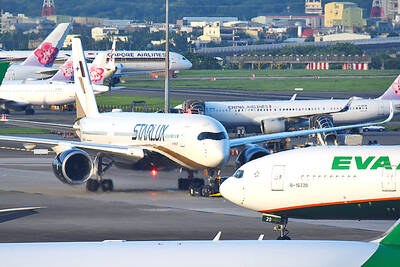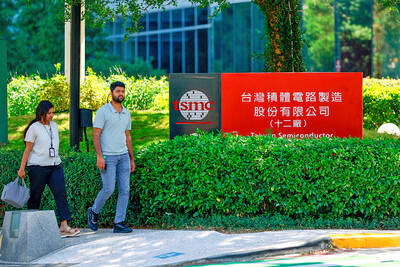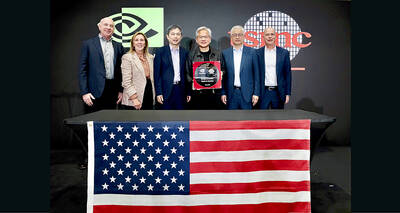A year ago, Amazon.com workers like 34-year-old Rejinaldo Rosales walked the aisles each shift to find each item a customer ordered and prepare it for shipping.
Now the e-commerce giant boasts that it has boosted efficiency by deploying more than 15,000 wheeled robots to crisscross the floors of its biggest warehouses and deliver stacks of toys, books and other products to employees.
“We pick two to three times faster than we used to,” Rosales said during a break from sorting merchandise into bins at Amazon’s massive distribution center in Tracy, California. “It’s made the job a lot easier.”

Photo: Reuters
Amazon.com Inc, which expected to face its single biggest day of online shopping yesterday, has invested heavily this year in upgrading and expanding its distribution network, adding new technology, opening more shipping centers and hiring 80,000 seasonal workers to meet the coming onslaught of holiday orders.
Amazon says it processed orders for 36.8 million items on the Monday after Thanksgiving last year, and it expected “Cyber Monday” to be even busier this year.
Chief executive Jeff Bezos vows to one day deliver packages by drone, but that technology is not ready yet. Even so, Amazon does not want a repeat of last year, when some customers were disappointed by late deliveries attributed to ice storms in the US Midwest and last-minute shipping troubles at both UPS Inc and FedEx Corp. Meanwhile, the company is facing tough competition from rivals like Google Inc and eBay Inc, and traditional retailers are offering more online services.
Amazon has forecast revenue of US$27.3 billion to US$30.3 billion for the holiday quarter, up 18 percent from last year, but less than Wall Street had expected.
However, Amazon has invested billions of US dollars in its shipping network, and its reliability is a big selling point to customers, Piper Jaffray investment analyst Gene Munster wrote in a note to clients on Friday last week. He thinks Amazon’s forecast is conservative.
The Seattle-based company now has 109 shipping centers around the globe. The Tracy facility is one of 10 in which Amazon has deployed the robots, using technology acquired when the company bought robot-maker Kiva Systems Inc in 2012, said Dave Clark, Amazon’s senior vice president for operations, who gave reporters a tour on Sunday.
More than 1,500 full-time employees work at the center. They are joined by about 3,000 robots, gliding swiftly and quietly around the warehouse. The robots navigate by scanning coded stickers on the floor, following digital commands that are beamed wirelessly from a central computer.
The system uses bar codes to track which items are on each shelf, so a robot can fetch the right shelves for each worker as orders come in.
The robots are expected to cut the Tracy center’s operating costs by 20 percent, Clark said. However, he was quick to say that they will not eliminate jobs.
“Our focus is all about building automation that helps people do their jobs better,” he said, adding that workers are needed for more complex tasks such as shelving, packing and checking for damaged items.

RECYCLE: Taiwan would aid manufacturers in refining rare earths from discarded appliances, which would fit the nation’s circular economy goals, minister Kung said Taiwan would work with the US and Japan on a proposed cooperation initiative in response to Beijing’s newly announced rare earth export curbs, Minister of Economic Affairs Kung Ming-hsin (龔明鑫) said yesterday. China last week announced new restrictions requiring companies to obtain export licenses if their products contain more than 0.1 percent of Chinese-origin rare earths by value. US Secretary of the Treasury Scott Bessent on Wednesday responded by saying that Beijing was “unreliable” in its rare earths exports, adding that the US would “neither be commanded, nor controlled” by China, several media outlets reported. Japanese Minister of Finance Katsunobu Kato yesterday also

China Airlines Ltd (CAL, 中華航空) said it expects peak season effects in the fourth quarter to continue to boost demand for passenger flights and cargo services, after reporting its second-highest-ever September sales on Monday. The carrier said it posted NT$15.88 billion (US$517 million) in consolidated sales last month, trailing only September last year’s NT$16.01 billion. Last month, CAL generated NT$8.77 billion from its passenger flights and NT$5.37 billion from cargo services, it said. In the first nine months of this year, the carrier posted NT$154.93 billion in cumulative sales, up 2.62 percent from a year earlier, marking the second-highest level for the January-September

‘DRAMATIC AND POSITIVE’: AI growth would be better than it previously forecast and would stay robust even if the Chinese market became inaccessible for customers, it said Taiwan Semiconductor Manufacturing Co (TSMC, 台積電) yesterday raised its full-year revenue growth outlook after posting record profit for last quarter, despite growing market concern about an artificial intelligence (AI) bubble. The company said it expects revenue to expand about 35 percent year-on-year, driven mainly by faster-than-expected demand for leading-edge chips for AI applications. The world’s biggest contract chipmaker in July projected that revenue this year would expand about 30 percent in US dollar terms. The company also slightly hiked its capital expenditure for this year to US$40 billion to US$42 billion, compared with US$38 billion to US$42 billion it set previously. “AI demand actually

Jensen Huang (黃仁勳), founder and CEO of US-based artificial intelligence chip designer Nvidia Corp and Taiwan Semiconductor Manufacturing Co (TSMC, 台積電) on Friday celebrated the first Nvidia Blackwell wafer produced on US soil. Huang visited TSMC’s advanced wafer fab in the US state of Arizona and joined the Taiwanese chipmaker’s executives to witness the efforts to “build the infrastructure that powers the world’s AI factories, right here in America,” Nvidia said in a statement. At the event, Huang joined Y.L. Wang (王英郎), vice president of operations at TSMC, in signing their names on the Blackwell wafer to